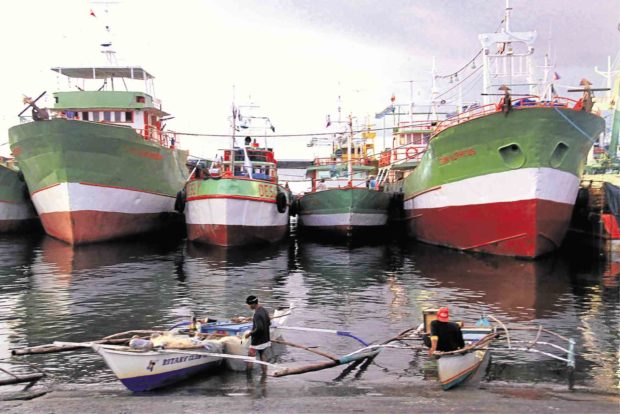Line fishermen prepare for another day at sea in Tayabas Bay, appearing to be unmindful of competition from commercial fishing boats like these (top photo) docked at a port in Lucena City. —PHOTOS BY DELFIN T. MALLARI JR.
LUCENA CITY — A national group of commercial fishers and fish traders denied they were engaged in child labor or illegal fishing in Tayabas and Lamon Bays.
The group also said the use of “purse seines,” although regulated, was not at all illegal.
“The engagement of children in fishing operations is against the law and detrimental to the overall welfare of children,” said Alonso Tan, president of Alliance of Philippine Fishing Federations Inc. (APFFI).
He said APFFI, mindful of the law, never allowed minors to work in their fishing vessels.
Tan was reacting to a statement by Tanggol Kalikasan (TK), a public interest law firm, which raised the alarm a week ago against illegal fishing in Tayabas and Lamon bays, with vessels allegedly tapping minors as workers.
TK also said “destructive” fishing methods, using “pangulong” (purse seines), “taksay” (ring nets) and “buli-buli” (modified Danish seine) were also back at the bays.
But Tan said the use of purse seine and ring nets was allowed by Republic Act No. 8550, or the Philippine Fisheries Code of 1998 as amended by Republic Act No. 10654. Tagging them as “illegal” was “unfair,” Tan said.
To prove that what they’re doing was legal, Noly Yu, Quezon-based operator of several purse seines fishing vessels, dared government and nongovernment organizations to board their vessels and document their operations.
“They are free to board our vessels unannounced, we welcome them,” Yu said. He also invited TK officials to a dialogue.
“It would be a friendly meeting to focus on how we can be of help to one another to save, protect and rehabilitate our seas,” Yu said.
Zeny Bernal, TK Southern Luzon program director, said some commercial fishing boats were allowed by law, but those weighing 10 tons were barred inside the 15-kilometer municipal waters, where small fishers operate.
“They should fish only outside the 15-kilometer area,” she said. “Once they’re inside, they are, to some degree, engaged in illegal fishing. They are also considered destructive because they offset the natural balance of marine life,” Bernal said.
